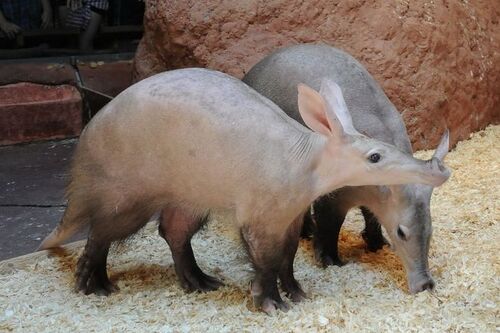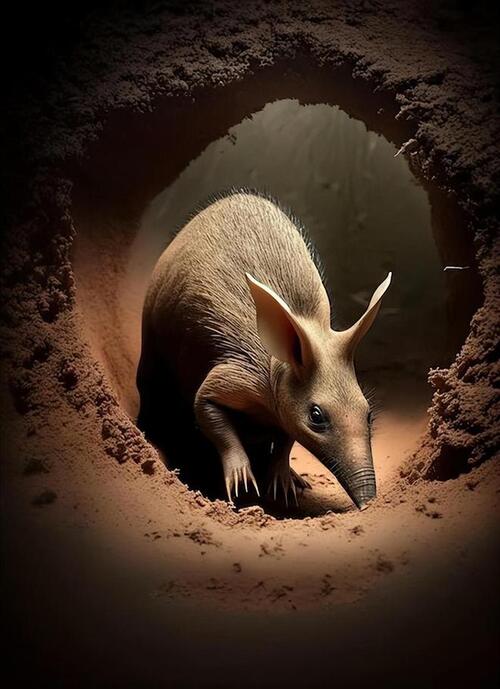Orycteropus afer
IUCN
LCBasic Information
Scientific classification
- name:Orycteropus afer
- Scientific Name:Native pig, anteater, African anteater, ant bear,Aardvark
- Outline:Rodents
- Family:O.afer Orycteropus Orycteropodidae Mammalia Tubulidentata
Vital signs
- length:1~1.5 meters
- Weight:50~60kg
- lifetime:8~12years
Feature
Pig nose, donkey ears, good at digging holes, a living fossil, but a poor sense of direction
Distribution and Habitat
Distributed from East Africa to South Africa south of the Sahara Desert.
Appearance
Elephant with bunny ears
Details

Aardvark (scientific name: Orycteropus afer), also known as: ground pig, anteater, African anteater, ant bear, is a mammal of the genus Aardvark of the family Aardvark of the order Tubulodonta. It is a living fossil animal. The fossil period is from the Pliocene to the present. The whole body is yellow-brown with sparse body hair; the head is narrow and long, and the snout is tubular; the tongue is slender, rich in mucus, and can be extended, which is mainly for eating ants in caves; the ears are long, large and thin; the limbs are strong, and the toes have strong and sharp claws; the tail is cylindrical, the tail muscles are well developed, the base is thick, the end is thin, and the skin is thick, like a small wild boar.
Aardvark is a mammal in South Africa and Central Africa, an elephant with rabbit ears. The body length is 1 to 1.5 meters (3 feet 3 inches-4 feet 11 inches), and it can reach 2.2 meters including the tail. The ears are long, the snout is like a pig, and the tongue is long and sticky. It has no hooves, sharp claws, and the claws are strong and powerful. The second and third toes are connected by webbed tissue, and it is good at digging holes. Lives in grasslands and woodlands. Eats ants and termites. Mainly nocturnal. Also known as ant bear or aardvark.
Aardvark is a large anteater. It is similar in size to a giant kangaroo, but is quite fat and weighs 50 to 60 kg; its skin is thick, reddish brown or white, and covered with sparse bristles; its head is narrow and long, with a tubular snout protruding forward; its tongue is slender, rich in mucus, and can extend; its ears are long and thin, similar to donkey ears; its limbs are strong, with strong and sharp claws at the ends of its toes; its tail is cylindrical, with well-developed tail muscles, thick at the base and tapering at the end, about 48 to 60 cm long. Distributed in East Africa to South Africa south of the Sahara Desert. Aardvark is a rare and peculiar animal, especially its teeth are unique. In adulthood, only two pairs of premolars and three pairs of molars can be seen in the upper and lower jaws. These molars have no roots, and each tooth has a tubular pulp cavity, without incisors and canines. Teeth grow throughout life, and the inside of the teeth is all dentine. Many parallel tubular extensions extend from the central pulp cavity, so on the chewing surface, it appears as a collection of polygonal tubules. The dentition consists of a pair of lower dentine plates and two pairs of upper dentine plates. The crushing surface of each bone plate is composed of localized parts of dentine, which in turn is composed of dentine columns generally on the surface of the dentine plates. These dentines are used to deal with thick-shelled marine invertebrates, whose small milk teeth have fallen off before the animal is born.

Aardvarks mainly live in hilly and semi-grassland areas. They live alone in deeper caves. They are very good at digging soil, digging quickly, and can escape into the soil within a few minutes. They can be called "tunnel digging experts" in the animal world. They are active at night, using their sharp claws to break anthills and using their long tongues to stick termites for food. They are cowardly and timid, lacking the ability to defend themselves, and rely entirely on their sensitive hearing to detect external enemy situations and hide or escape into caves as soon as possible. Young aardvarks are naked and close their eyes, and will not leave the cave until half a year later. Aardvarks are highly adaptable to the environment; they live alone and have a weak sense of territory; they are nocturnal, resting in caves during the day and foraging from dusk to dawn. They have a highly developed auditory perception system that can detect faint sounds in the surrounding environment. This keen hearing helps them perceive potential threats, so they can avoid high temperatures and predators. At night, they can travel 10 to 30 kilometers, often stopping to sniff and press their "pig noses" on the soil. The fleshy sensory organs on the nasal septum may detect tiny underground movements. When they find ant nests underground, the aardvark licks the ants or termites with its 30-centimeter-long, mucus-covered tongue.
Aardvarks are omnivorous animals, and their main food is animal food, including various insects, small rodents, and bird eggs, but the main food is ants and termites. The sturdy limbs and sharp claws indicate that aardvarks are outstanding "digging tigers", and they dig holes faster than 10 adults using pickaxes. The termite nests on the African grasslands are several meters high and as hard as cement. Even if they are cut by knives or axes, they can only leave shallow marks. However, the aardvark can easily deal with them. After it breaks the anthill, it uses its thin and sticky tongue to eat the fleeing termites. The aardvark has a large appetite and can eat 50,000 termites in one night. The difference between it and the anteater is that it is nocturnal.
The caves dug by the aardvark usually have multiple entrances and exits and multiple tunnels, which can form a complex underground network. Some animals choose to build their nests in the caves dug by the aardvark.

Aardvarks are seasonal breeding animals, polygamous, and give birth in summer. They live together only when they are in heat and mate from March to May every year. Male and female aardvarks will cross-breed. The male's genitals produce musk, while the female produces this musk from the glands in the elbows. This smell helps attract and cause mating. The gestation period of females is about 7 to 9 months, and they give birth in October to November. Each litter only produces one cub. The aardvarks in their infancy are like hairless cats, naked and do not open their eyes. The cubs can live independently when they are 6 months old, and they are sexually mature at 2 to 3 years old, with a lifespan of 8 to 12 years.
In Africa, aardvark's den is a unique landscape. The caves are 3 to 12 meters long, but sometimes they are connected to each other and can stretch for more than ten or even dozens of kilometers. The bad thing is that the "homeowner" who is easy-going and erratic has a poor memory and often forgets the old den and builds a new one. Therefore, the aardvark's home is often borrowed by other animals. You can find lizards, pythons, cobras, honey badgers, warthogs and even large animals such as lions and leopards in them. Local natives occasionally use aardvark's den to shelter from wind and rain.
FAQ
What is an aardvark?
An aardvark is a nocturnal mammal scientifically named Orycteropus afer, primarily found in the grasslands and savannas of Africa. It feeds on ants and termites, earning the nickname "ant pig."What are the physical features of an aardvark?
Aardvarks have a unique appearance: their bodies resemble pigs, their ears look like a rabbit's, and they have a thick tail similar to a kangaroo's. They possess strong front claws for digging.How do aardvarks catch their prey?
Aardvarks use their keen sense of smell to locate termite mounds and ant hills. They dig into the nests with their powerful claws and use their long, sticky tongue to catch ants and termites.What threats do aardvarks face in their habitats?
Aardvarks face threats such as habitat loss, climate change, and hunting. Due to their secretive behavior, it is challenging to estimate their population accurately.What role do aardvarks play in the ecosystem?
By digging termite mounds, aardvarks help control ant and termite populations, contributing to ecological balance. Their burrows also serve as shelters for other animals.







